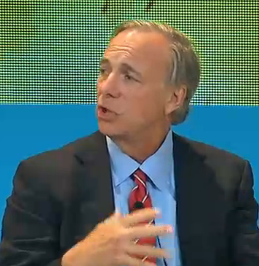
Find above a video of Ray Dalio of Bridgewater – probably the most successful hedge fund in history – debating risks and opportunities with a couple of private equity legends.
From Pragmatic Capitalism, here are the salient points:
- Yields can’t go down anymore.
- Austerity is coming.
- Economy is running out of steam.
- QE is losing its efficacy.
- Rate turn probably finally coming late in 2013.
- The world is still in deleveraging.
- Sounding bearish: Risk premiums are likely to expand.
- It all comes down to interest rates. As an investor, all you’re doing is putting up a lump-sump payment for a future cash flow.
- In all deleveraging, you get through them by having an interest rate that’s lower than the growth rate.
- The big question is: When will the term structure of interest rates change? That’s the question to be worried about.
- Effects of QE diminishing as we do more rounds.. We’re facing austerity. And growth is flagging. This is an unprecedented risk the economy is facing. A slowdown with very little room to maneuver.
- The yield curve is certainly at the bottom. And so we’re squeezed on where they’ve gotten us in terms of.
Advertisement
Dalio, from a US perspective, calls the current situation a “beautiful deleveraging” . He and his firm Bridgewater deal in probabilities, not certainties, in their portfolio approach, so don’t be mislead by his ambiguity or lack of conviction calls. As he said the other day:
He who lives by the crystal ball will eat shattered glass..

